How to create a family garden – 14 child-friendly garden ideas
What does the term ‘child-friendly garden’ mean to you? Does a family garden have to have lots of colourful plastic and a bald lawn?
You can have a garden that both you and your children love – without spending a fortune. Garden and landscape consultant Matt Jackson is often asked to advising on creating outdoor spaces for families or family tourism. And he is now creating a new garden for his own young family. Here are his top tips:
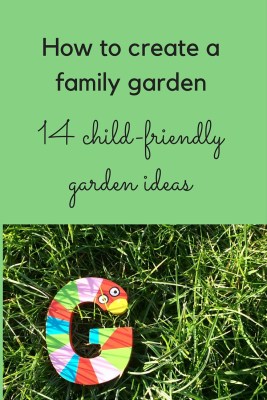
Relax your expectations – let your children flourish
‘I grew up in North Cornwall as one of four boys, and enjoyed an active and free childhood in large gardens and countryside. My mother had grand ideas about a beautiful garden full of roses and cottage flowers, and my father liked cut grass and strictly controlled trees and shrubs.
My brothers and I liked football, cricket, wrestling, bicycle circuits, den building, climbing, and the list goes on. A good football match with friends might see half a dozen boys hoofing a ball around a garden, with a rose shrub acting as a midfielder, the berberis a defender and the Paeonias simply in the way.
But we all got some of what we wanted, and have over-whelmingly positive memories of the garden.
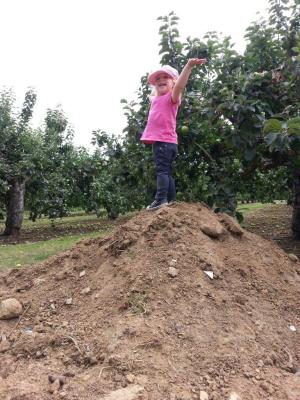
Love mud! Don’t worry too much about children getting dirty or plants getting trampled on. Both recover quickly.
‘I tell this story because it adds realism to expectations. Last week, I cleared the lavender border. Cicely (aged 3) has immediately seen it as a great new place to dig for mud pie ingredients.
The first and fundamental rule to making a real family garden is to relax your expectations. Children will flourish in a safe environment that provides freedom to explore and experiment.
2) Create your own personal safety strategy
You won’t enjoy the garden if you always have to watch the children when they want to play. Everyone has different expectations about safety, and children range in ages, so the solution is very individual. Do your research and ask experts, but in the end, listen to your instincts. Make sure you end up with a garden that you personally feel is safe.
3) Family-friendly garden safety basics
These are the essentials of a safe child-friendly garden.
a) No water – not even a trough, water butt or deep bucket, if it can be accessed unsupervised. A toddler can drown in a few inches of water. If you already have a pond, you can get purpose-made safety grids to go across the water to prevent children falling in.
b) Containment – a barrier will keep different areas of the garden separate (especially to prevent toddlers from escaping to the road), but it needn’t be an ugly wire fence. A low hedge with wire behind, woven hazel hurdles, dense shrubs, a farm gate or low wall will do.
c) Soft landings – if they can go up, make coming down as soft as possible. Lawn is good.
d) Check for irritant or toxic plants: the RHS state ‘’serious poisoning by plants is very uncommon in the UK. Some garden plants present a hazard, but the risk of severe poisoning, skin reaction or allergy is generally low’’.
The best advice that I can give is to check what you already have in the garden, and only to buy new plants that are safe (most are, and they are labelled). If in any doubt get the advice of a professional gardener. The RHS list of toxic or irritant plants, plus what to do about them, is here.
4) Design a child-friendly garden in zones
Most adults want an area for themselves, and an area for children, particularly the play equipment. Think about it in concentric rings radiating from the house.
The first area should be the safest – close to the house, where you can see very young children clearly even if you aren’t outside with them. Half of our garden is fenced, keeping the stream and steep sections out of bounds, allowing for slightly hands-off supervision.
Of course, near the house is also the best place for the ‘show garden’ – but instead of a battle for space, consider that children want to be in the garden WITH the adults. As we teach them sharing and respect, we need to do the same. It may not seem like it at the time, but the toddler stage doesn’t last very long. A few years of plastic toys all over the terrace will pass very quickly.
5) Further out, design a second area – for all
If you want an area for swings, slides or play equipment – in order to screen them from the house – then make it comfortable for you to be in too. Add a sheltered spot, a gazebo, or a comfortable, reclining seat, where you can sit and enjoy a hot drink, read, and get WiFi signal.
Children go through key developmental stages. One is the step when they play out-of-sight of adults. It is good to allow this, and important that they know they can return to you easily. So this second zone may ultimately be where they hang out with their friends, when they are a little older.
If your garden is big enough, you may also include a third, wilder zone where children can roam or play ball games when they’re old enough to be unsupervised in the garden. If you have a long thin garden, a third area at the end for seating or a shed may be a useful sanctuary for older children and teenagers to gather away from the house.
6) What child-friendly garden equipment to buy?
Play equipment is often completely unsympathetic to the style-loving gardener’s plans – bright, bold, large and plastic. Natural timber options are expensive and need annual treatment, or don’t last if cheaper. A large climbing frame can start at a £1000 and skyrocket, especially if you consider levelling the ground for it and installing a safe fall zone. If installing a frame, you should consider a weather proof base or it becomes muddy in the winter, so bark or something like bonded rubber crumb is a good idea. Two of my favourite natural play area companies are Caledonia Play and Active Garden.
Swings and Wendy houses seem to maintain children’s interest longer than some of the more complex options.
7) Save money with second-hand and DIY options
There is of course the do-it-yourself option, which can be especially good because the children can join in and have a real sense of ownership. We made our ‘fort’ using commercial wooden apple bins. They are designed to stack, and can be secured together, so make a great modular building option. What’s more, the bins we sourced were old stock, and, at £6 each, made a great structure for £24 and a bit of elbow grease.
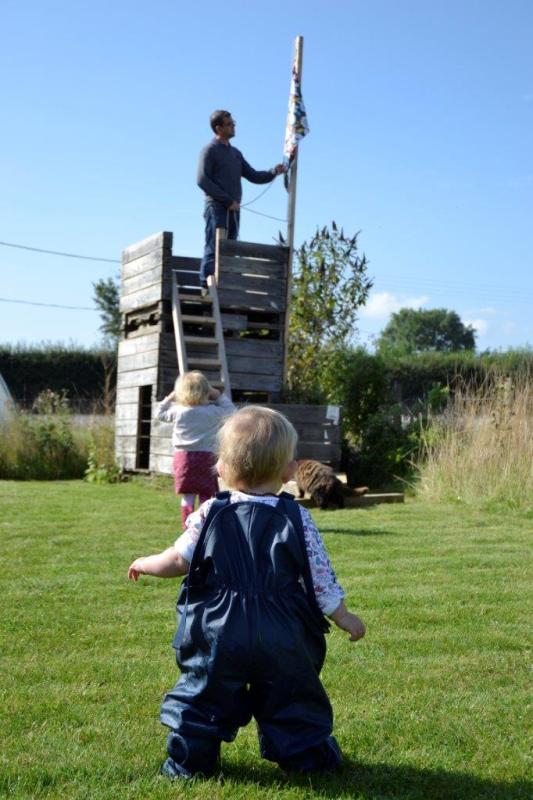
Matt and the girls build an apple box ‘fort’ – check that the structure is sound and won’t topple over when children play on it.
Another good idea is to go to the local second-hand furniture shop and get an old sideboard or two, then some pots and pans from a charity shop, and set them up with a mud kitchen. I have yet to see this method be met with disapproval!
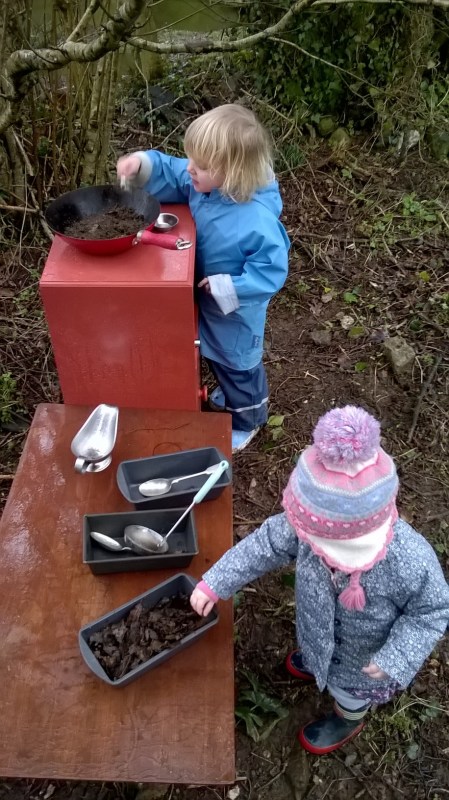
Cicely and Tilia love playing ‘mud kitchens’ with second-hand furniture and utensils picked up from a charity shop for £11 in total.
8) Children outgrow expensive equipment quickly.
Perhaps the greatest lesson that I have observed with my own children and with clients, is that however fancy the structure, children can tire of it quickly. They like repetition, but change too, so look ahead when planning what to spend your budget on.
And a child-friendly garden doesn’t have to mean spending lots of money on new equipment that will soon be discarded. Your best bet might be to invest in games and toys that can be used outside, such as ball games, tricycles etc rather than playground-scale fixtures. Toys – and old blankets and cushions, garden chairs and not-very-precious picnic ware – can be put away in a weatherproof box or shed at bedtime, to be replaced when children outgrow them.
But embrace change. Garden professional Posy Gentles has 4 children. She says: ‘Both gardens and children change quickly, so enjoy the idea of something new every few years. For example, if you have children under 5, then you will probably get around 5 years play out of Wendy houses, climbing frames and slides. Then you can replace them with something else. If your children are nearly teenagers, then a secluded, sheltered place to sit may be a better investment.’
(To buy a shiplap Wendy House from Amazon, click here 7×7 Wooden Kids Playhouse ♦ Childrens Lily ♦ Shiplap T&G ♦ Roof Felt & Floor)
Note: links to Amazon are affiliate links, see disclosure.
On the other hand, a simple shed may work as a Wendy house in the early years and as a teenage den later on.
9) If you’ve only got a small area…
Don’t fall into the trap of emptying the garden of plants in order to leave as much lawn in the middle as possible. If your garden isn’t large enough for ball games, you can’t change that.
Give your children a different sort of fun: they will enjoy chasing each other around beds, shrubs and trees or playing hide-and-seek behind them. And there’s always the local park or going on country walks together.
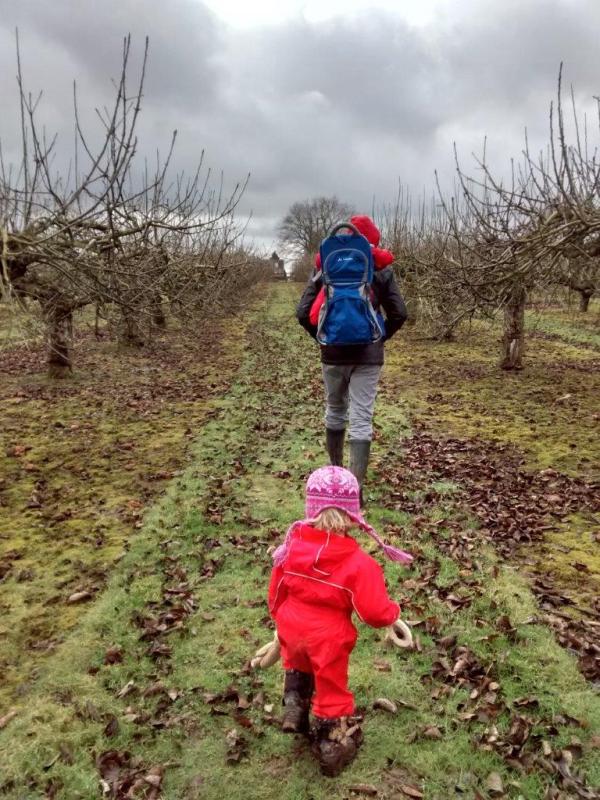
Take children on country walks from an early age.
10) Child-friendly surfaces:
Stone and brick are good for riding bikes and trikes, and for all other wheel-related games. Grass and bark chippings are soft to fall on or crawl over. Gravel, however, isn’t good for bikes and hurts when you fall on it or crawl over it.
11) Keep some mature trees and shrubs
This is another tip from Posy: Before taking out mature trees and shrubs, consider their role in the child-friendly garden. A good strong tree is perfect for a tyre, swing or a rope. Mature shrubs are good hiding places or can be used as the basis for a makeshift den. Bigger trees also offer shade in hot summers, and may support a hammock for teens.
Shrubs are also low-maintenance, so if you’re busy working and bringing up a family with little time for gardening, see this post on brilliant low maintenance plants.
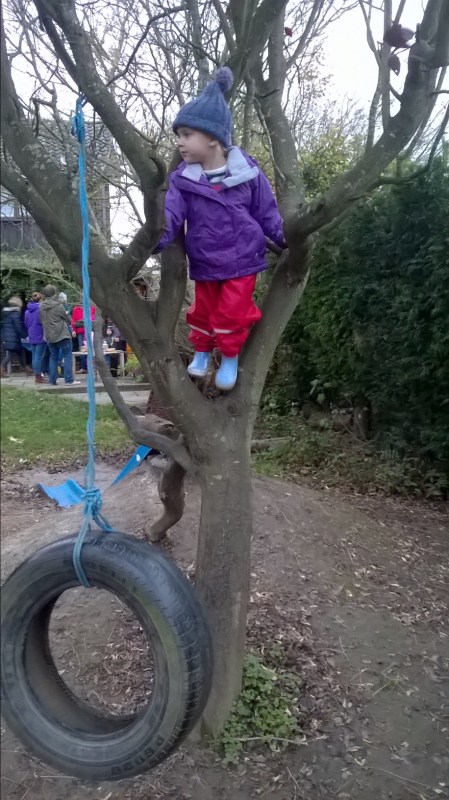
Mature trees and shrubs have a role to play in the child-friendly garden.
12) Have fun in the garden
Once you’ve got your family-friendly garden, play in it – teach your children the names of your local birds and butterflies, keeping a record of what you all spot. Grow some easy seeds, plant an apple pip in a pot or make a daisy chain. For more ideas, see the BBC’s ‘gardening with children’ page.
Our best buy has been really good waterproofs, that can be muddied fully and without care. We take the girls out in the rain, all winter, and they rarely complain.
13) Don’t worry about keeping the garden perfect
Alexandra asked her daughter, Rosie Iron, what she’d most liked about gardens in her childhood. ‘I loved the gardens that looked a bit like a wilderness,’ said Rosie. ‘Especially if there were trees and shrubs we could use as a base.’
14) The most important thing in the child-friendly garden is…
You. The greatest investment that you can make in the child-friendly garden is time – your own time. At a young age our children simply want to be close to us, to learn how to exist in the world, and to feel security. Being in the garden with the children helps you and them form the connection with it, and it being a safe enjoyable space.
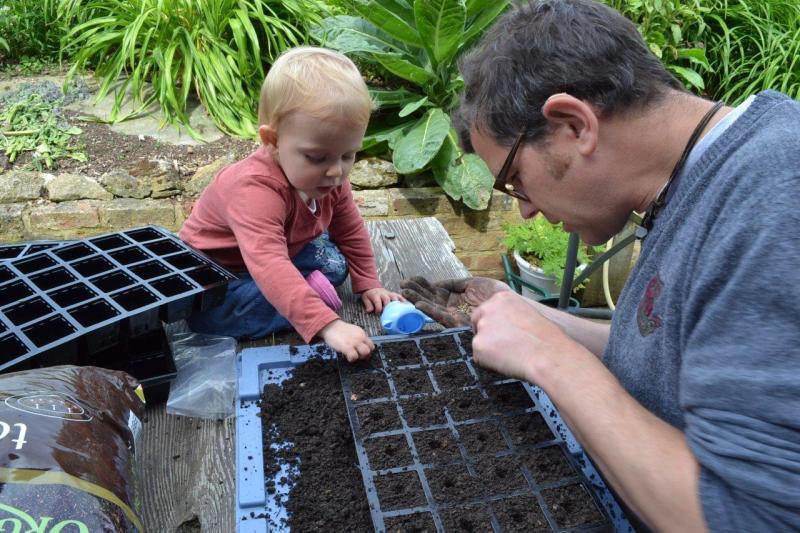
Daddy’s little helper. Tilia starts her gardening education early.
As they grow they’ll want to explore, test their boundaries and still feel safe. In a child-friendly garden, we can give them those boundaries and keep them interested by also being interested ourselves. Above all, we can show them them the areas to respect and those to explore freely.
Matt Jackson works on landscape design, heritage and management with Land & Heritage, a consultancy specialising in the heritage sector. He was formerly Gardens Manager at Sissinghurst and Head Gardener at Doddington Place Gardens. He is also a writer and broadcaster – his book Lunar & Biodynamic Gardening is published by Cico Books (affililate link).
For help with landscape management, environmental surveys, managing land for tourism and conservation, contact Matt Jackson or Land & Heritage.
Do let us know your child-friendly garden tips in the comments below – we’d love to hear from you. Thank you!
Shop my favourite garden tools, books and products
I’m often asked for recommendations, so I’ve created some useful lists of the garden tools, books and products on The Middlesized Garden Amazon store. For example, if you’re just starting out in gardening, here is my list of essential gardening tools, and the brands I use myself.
Or if you’d like to make sure that your gardening is environmentally friendly, see my Favourite Sustainable Gardening products.
Pin for reference:
Remember child-friendly gardening ideas by pinning it to Pinterest.
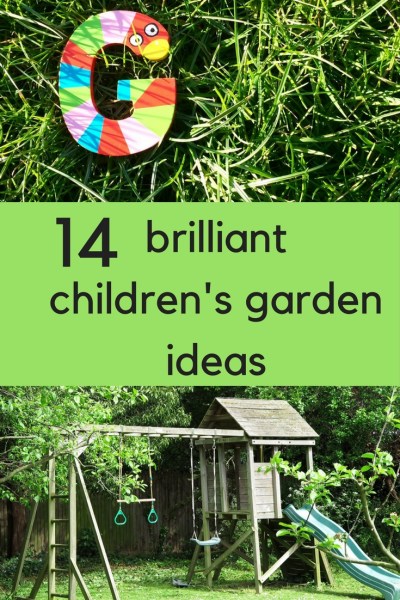
























Hi, thanks for recommending our website for play equipment.
I would like to bring to your attention, that all the climbing frames we sell have pressure treated timber, which does not need treatment every year. This is something customers should check before buying a climbing frame, as this type of timber would save them a lot of work throughout its lifetime. The timber we supply has a 10 year anti-rot and infestation guarantee. These climbing frames are sturdy and last for many years, so treating them every year is not something people will want to do, so with the timber we supply, there is no need. The single climbing frames with treated timber start at around £ 500, so not as expensive as people may think. If you need further advice, we are very experienced and knowledgeable and are happy to help!
Active Garden Ltd
Thank you for letting us know.
Lovely post, thank you!
Regarding weeds, I do leave young nettle shoots to grow as I turn them into soup and omelette together with my 3 year old! Many weeds are medicinal plants and some really beautiful like the dandelion! I love the fact that they pop up almost anywhere and bring such a vibrant colour. Hence I think one should thread with care and children can learn from a young age the use and powers of different plants and see them less as “weeds” and more as useful friends to one’s self-sustainability.
That sounds lovely. I often think of picking nettles for soup, but I’m never sure if someone might have sprayed them recently. But if I get any in the garden, perhaps I will let them grow enough to try it.
Brilliant ideas. I struggle to successfully zone our garden but this have given me ideas. I am planning to build a play structure out of wood so it doesn’t look out of place in our very rural setting. I love Earthwrights, a company local to me , their play structures are amazing and don’t fill the garden with plastic! http://earthwrights.co.uk .
Thank you for letting us know about them.
You’ve made a good point – it’s definitely worth thinking about how much care your garden plants will need. Shrubs and grasses, generally, don’t need much attention, while annuals need re-planting, dead-heading, fertilising, staking etc. However, weeds and nettles don’t grow around particular plants – they tend to grow in bare earth, so having easy-care plants that spread is probably the best way of minimising weeding. Though I fear that weeding will always be with us….